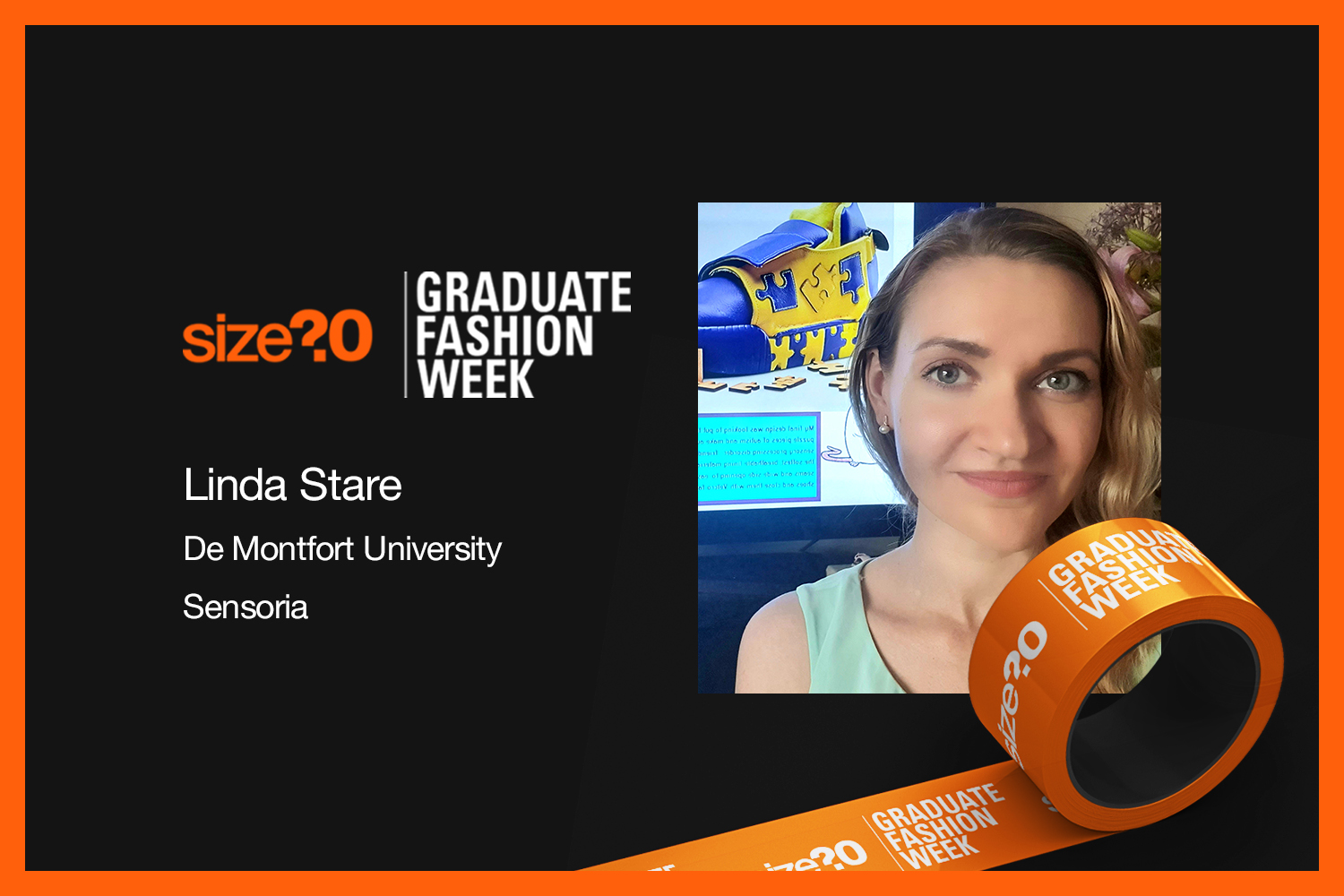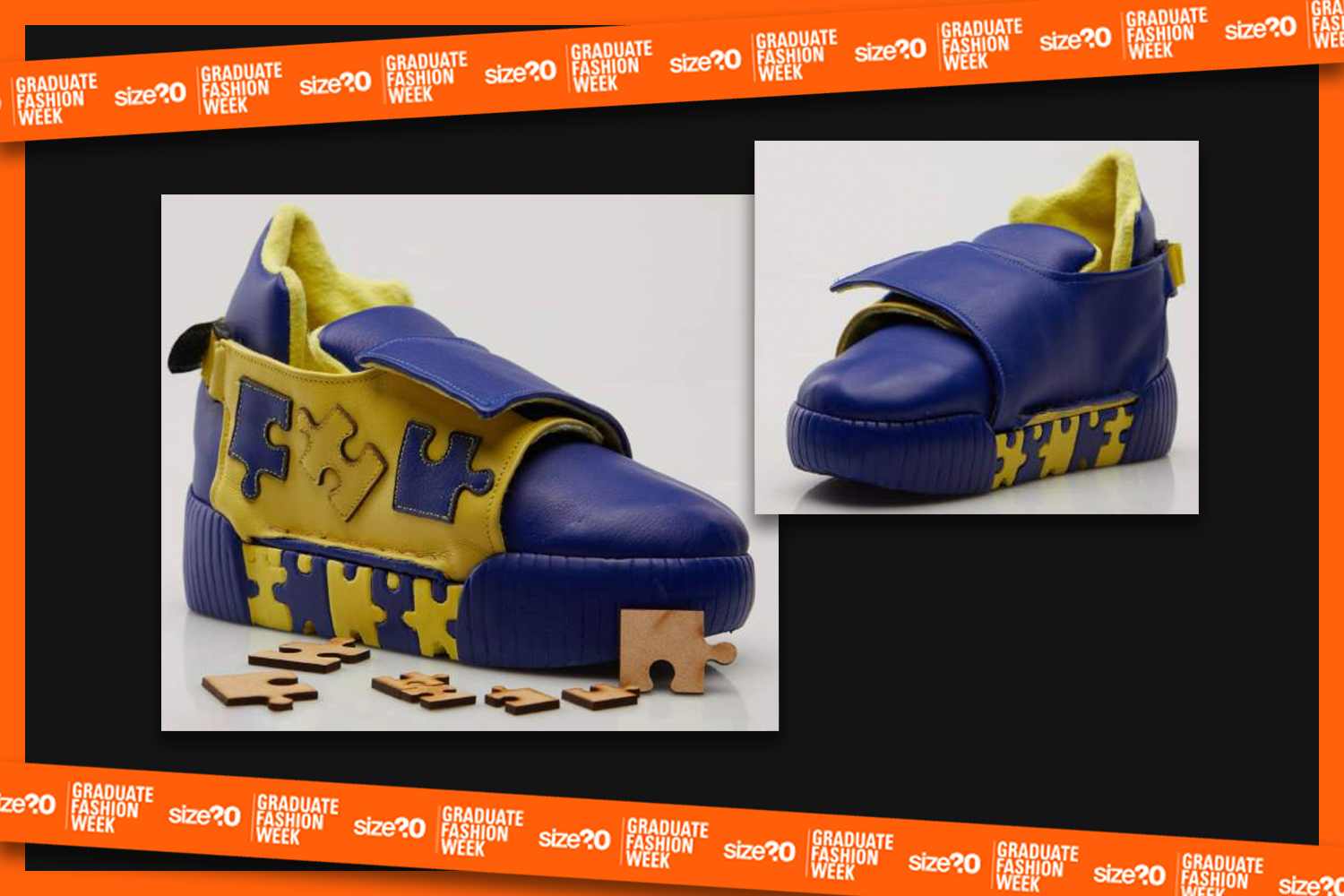Take a look at the size? sponsored Footwear Award entries – Graduate Fashion Week 2020

We’ve loved every second of working with Graduate Fashion Week over the past two years, and we can’t wait to team up for the third time for GFW 2020. And after two years of sponsoring the Photography and the Styling and Creative Direction awards, we’re made up to be the official sponsors of an award that’s true to our roots and passion, the Footwear Design Award.

The award will be looking out for a unique and innovative footwear concept that expands the boundaries of shoe-making to create the best possible environment for the foot. Often a new approach to delivering functionality drives the most beautiful and distinctive details, with that in mind we’ve encouraged all students to be creative, innovative and push those boundaries.
The panel will pick out one well-deserving winner from a 10 student shortlist to win a special prize. So before we get around to selecting a winner, we thought we’d take a snapshot of each entrant’s portfolio to give you an insight into their work and inspirations.
Anna Melegh – University of Northampton

Project name: ReInvent
For Anna, her goal was to create a comfortable piece that is more than just a shoe. She has a real passion for the natural world, especially bugs and butterflies and the habitats they live in.

Anna highlights that the rate of extinction in insects is eight times faster than that of other species which threatens a catastrophic collapse of nature’s ecosystems.
“The aim was to give spotlight for insects, as fashion has the power to highlight various issues and to raise awareness of the conservation and the beauty of nature and natural materials,” – she states when discussing her ideas.

She also highlighted her visit to Iceland and their fish leather tannery as another key influence in her work: “I decided to make my own leather at home from the waste of the fishing industry. I believe in a change for the footwear industry; what we take from nature could return to nature.”
“In the future, I would like to set my own business offering more sustainable shoes, and for that, I’m planning to continue to study further.“
Caleb King – UCA Epsom

Project name: Nike Drift
For Caleb one of his key influences came after witnessing the banning of the Nike VaporFly for competitive athletic events.

“I started to see how sneakers have a fundamental role in major running events. This pushed me to challenge the boundaries of how a sneaker can amplify your performance and protect and innovate the digital and physical environment.”
It gave Caleb the idea of creating a shoe partially made out of algae foam.

He explains – “It’s a unique approach as it will not only decrease the unwanted demand for algae foam but when the shoes are worn, they will naturally consume CO2 and release oxygen. In the long term, the production of the shoe will become carbon neutral. If large groups of runners wore the sneaker, air pollution in cities could start to become a thing of the past.”
Speaking about the future, Caleb tells us: “I would love to be working with new and innovative technology and prototypes that can impact the sneaker world, whether that’s experiential retail strategies or designing to impact and change the future of design.“
Daseul Eom – De Montfort University

Project name: Sugie Bootie
Daseul believes that all beautiful things carry marks and scars, and that’s what makes them treasured and unique items. She lists the Japanese concepts of wabi-sabi and Kintsugi as big influences in her work.

“Wabi-sabi is a Japanese concept of living life while accepting all its imperfections and impermanence gracefully. As depicted by the name, ‘Wabi’ refers to rustic beauty, simplicity and the uniqueness of the things, and ‘Sabi’ refers to the beauty that comes with age.”

“Kintsugi – also known as Kintsukuroi – is an art form from Japan that deals with fixing broken pottery by using liquid gold or other precious glue that forms a unique design on its own.” – an aesthetic used throughout her work.
Sustainable alternatives and eco-conscious fashion are another inspiration in her project – “Brands are trying to offer sustainable alternatives to the market. Based on this trend, I decided to be more eco-conscious and incorporate 3D-printing techniques and use recycled and sustainably-sourced materials.”
Ellie Gray – De Montfort University

Project name: Avant Gray
Ellie’s Avant Gray men’s footwear collection draws inspiration from Scandinavian furniture and design principles. She’s created designs that are minimal and available in versatile colourways, which she believes gives the shoes a greater life span.

“Quality and sustainable materials are used to enhance longevity and are relevant to the modern environmentally-conscious consumer,” – she states.

“Comfort is also important; all linings are made from soft calf leathers or suedes and every insole is padded, cushioning the foot. The shoes are designed with a handcrafted aesthetic in mind. The mahogany detailing that features in the sneaker is handcrafted, upcycled from pre-loved furniture.”
Esme Whitelam – De Montfort University

Project name: Space Oddity
“Space Oddity is an exploratory footwear collection, aiming to go where no kidswear collection has gone before. Let’s let kids be kids; let’s let them wear shoes as unique as they are. Space Oddity is a genderless collection made to be inclusive, with no boundaries.” – Esme tells us.

This project features futuristic, astronautical-inspired silhouettes which combine technical detailing, materials and colours from different NASA spacesuits from over the years to create a collection that is out of this world.

Esme also took an eco-friendly approach to her project – “With fast fashion becoming an increasing concern to many consumers, our approach to manufacturing and accessibility means that shoes are made to order, which avoids deadstock and excessive waste. Also using recyclable materials and not using glues to construct the shoes allows us to deconstruct our shoes and reuse them.”
Faith Garba – De Montfort University

Project name: L’ Arte della Consapevolezza
Faiths project is all about minimising the environmental effects of fashion and footwear and implementing foot reflexology with the design of shoes.
“I researched the effects of common materials used in footwear and I identified the repurposing of material as a possible solution to the problem.”

Faith put a lot of research into the key aspects and benefits of foot reflexology and looked at how this can help supination and the pronation of the foot.

“I have tried to place foot reflexology shapes where I believe it would be helpful for people who either pronate and supinate. I wanted to bring awareness to the fact that our feet go through a lot every day. Looking after the foot is a way of preventing issues with the foot before they occur.”
Hyunjee Park – De Montfort University

Project name: Gothic Architecture

Hyunjee – or J as she prefers to be known – aims to melt gothic architecture into her capsule collection. She explains – “The exterior of the gothic looks sharp and high, but I got many pattern ideas from the pointed arch of the interior structure and the ribbed vault which looks like flowers.”

Hyunjee talked us through each silhouette in her collection – “The capsule contains three designs: a high-heel that represents gothic architecture’s exterior which is pointy and high; a middle-heel that depicts the feeling of triforium’s window designs; finally, a trainer that goes well with the pointed arch and the smooth, curved design.”
Linda Stare – De Montfort University

Project name: Sensoria
Linda strives to make a design for children with sensory processing disorders because, as she highlights, there isn’t currently a lot of footwear brands who mark their shoes as ‘sensory-friendly’.

“There are a lot of children with sensory processing disorders who like to play with sensory toys, and every day they’re having meltdowns due to uncomfortable shoes because they are hypersensitive than others,” – she goes on to explain.

Her final design is an autism and sensory processing disorder-friendly shoe – “They feature the softest, breathable lining materials; reduced seams, wide side openings put on shoes and Velcro fastening for easy off and on.”
Louie Bond – De Montfort University

Project name: Built For Last
Louie has designed a collection of men’s lifestyle/outdoor sneakers that draw influence from the Supermarine Spitfire used by Britain and the allied forces during World War II. He takes inspiration from the aircraft’s harness and seatbelts, as well as its military colour scheme which fits in with autumn/winter colour trends.

“I wanted to find a new approach to functionality,” – he reveals.
The brief asks the students to create a unique and innovative shoe that pushes the boundaries of shoemaking to create the best possible environment for feet. This gave Louie the idea to design a shoe with a multi-function feature and a detachable waterproof cover.

“The multi-function of the cover helps to enhance sustainability, as the shoe will last longer. It’ll also help to stop the ‘fast fashion’ idea and support the ‘buy to last’ movement that is trending at the moment.”
Sesong Ju – De Montfort University

Project name: Giwa
The design inspiration for Sesong Ju’s footwear collection comes from South Korean ‘Hanok’ houses and their fusion of eastern and western design.

“In modern Korean villages, you can see cathedrals built in the 90s – a fusion of eastern and western cultures. I think these things have permeated into my design and come out as an advantage of creating shoes by mixing eastern and western cultures with leather and textiles.”

Sesong also revealed that the reason she became interested in shoe design is down to her father’s steady taste in shoes.
“From the past to the present, his loafers were dark brown-coloured Tod’s driving shoes. He wore various designs for sneakers, but the loafer was always the same. My dad said the shoes look good everywhere and they are the best classic design shoes. So, then I thought I wanted to make shoes with classic designs that people could wear for life.”







